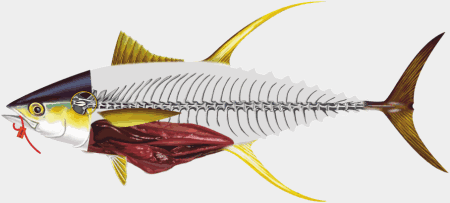What is the Biological Sampling?
 It consists of collecting up several tissues on specimens (mostly fish) caught during observer trips, tuna tagging cruises or scientifc trips.
It consists of collecting up several tissues on specimens (mostly fish) caught during observer trips, tuna tagging cruises or scientifc trips.
It is essential that these samples are collected properly in different regions and at different times. These samples can be as diverse as:
- Stomach
- Muscle
- Liver
- Gonad
- Otolith
- Spine
- Blood
- Fin
These samples are then used to run analysis:
- Stomach to describe diet composition
- Muscle, Liver and Blood used as natural tags (Isotope) and to analyse contaminants
- Gonads used for reproduction biology studies
- Otoliths to estimate age and growth of fish
- Spines used for age validation
- Ecosystem approach of fisheries management: Diet, micronekton
- Support stock assessment with estimation of species’ biology: Reproductive biology, growth rate, stock boundaries
- Scientific studies with implication in fisheries management: Contaminant
The overall aim is to improve our understanding of biology and ecology of tuna species for a better management of Pacific fisheries.
What is the Pacific Marine Specimen Bank?
Since 2001, SPC’s Oceanic Fisheries Programme (OFP) has been coordinating the collection of biological samples of pelagic species from all over the Pacific Islands region on behalf of its member countries. Initially, this collection was focussed on stomach, muscle and liver samples to understand the trophic structure of the pelagic ecosystem (i.e. who eats who, where, and when); however, this has expanded to include gonads (repro-ductive organs), otoliths (ear bones), spines and blood, giving the opportunity to study reproduction, age, growth and contaminant concentrations. The collection is ongoing thanks to the partnership with the fisheries observer programmes operating in the western and cen-tral Pacific Ocean (WCPO).
A group of experienced senior “at sea” observers and port samplers participate by collecting samples from each trip or unloading they participate in. Rather than collect numerous samples from a single trip or unload-ing, they collect samples from a small number of indi-viduals from each sampling session. This ensures that the sampling activity does not take too much time and that many more fishing trips and vessel unloadings are sampled to achieve OFP’s collection targets.
OFP aims to have approximately 2,000 fish sampled for each species in order to allow Pacific-wide studies to be undertaken. The ongoing status of the collection means that as some samples are withdrawn from the collection for scientific analyses others are deposited to maintain the collection for future analyses. The collection is also supplemented by scientific surveys that are undertaken by SPC and other organisations.
Presently, sampling activities are coordinated in the Philippines, Palau, Papua New Guinea, Solomon Islands, Federated States of Micronesia, New Caledonia, Vanuatu, Fiji, Marshall Islands, Kiribati, Samoa French Polynesia and Japan
How the collection is used?
The application of ecosystem-based management in the WCPO means that decisions are made by balancing positive and negative impacts of proposed actions on the ecosystem. To assist decision-makers with this balancing, the Pacific Marine Specimen Bank (PMSB) has been used to analyse the trophic structure of the western Pacific in order to construct ecosystem models to explore the effects of fishing and environmental variations.
Assessing the status of tuna stocks is also reliant on the estimation of the species’ biology. The PMSB has recently been used to estimate the length-at-age relationship and reproductive biology of the albacore stock in the South Pacific. This was the first stock-wide analysis of these parameters for a tuna stock in the WCPO. Similar analy-ses are underway for bigeye tuna in the WCPO.
The French Institute for Research and Development is currently implementing a study to determine the origins of mercury and its accumulation and distribution in top predators, and is withdrawing muscle and blood sam-ples from the PMSB. Mercury levels are used to track tuna foraging habitats and tuna migration as well as revealing possible public health problems.
An important area that the PMSB will contribute to is the emerging application of fisheries forensics to assist with the validation of catch documentation, traceability and surveillance for illegal, unreported and unregulated fish-ing activities. Genetics, genomics, chemistry and foren-sics are becoming well-established tools for this purpose. They are also increasingly valuable tools for indirectly monitoring movement, stock structure and reproductive dynamics. Recent withdrawals from the PMSB have been used to examine movements and spawning locations in South Pacific albacore using elemental and isotope chemistry. Withdrawals have also recently been made to understand the genetic structure of albacore, skipjack, bigeye and yellowfin tunas in the western Pacific.
 Pacific Marine Specimen Tissue Bank
Pacific Marine Specimen Tissue Bank